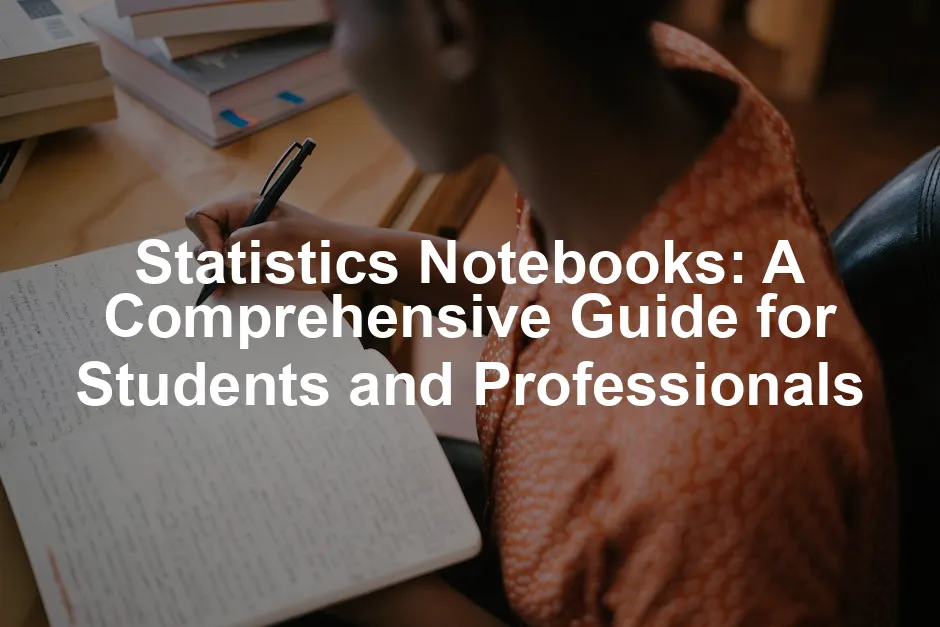Introduction
Statistics notebooks are essential tools for anyone involved in data analysis. They help organize thoughts, methods, and results, making analysis more efficient. You can choose from traditional paper notebooks or modern digital platforms. As statistics gain importance in fields like data science, economics, and social sciences, the right notebook can enhance your learning and work experience. For instance, a Moleskine Classic Notebook offers a stylish and functional option for jotting down your thoughts.
Summary and Overview
In this article, we will explore various aspects of statistics notebooks, their significance, and how they can improve your statistical analysis skills. Effective note-taking is crucial in statistics, as it aids in understanding complex concepts and retaining information. Organized notebooks benefit students, educators, and professionals alike by keeping crucial data easily accessible. We will discuss different types of statistics notebooks, including digital, physical, and interactive options, and their unique applications in education and professional settings.

Types of Statistics Notebooks
Digital Statistics Notebooks
Digital statistics notebooks are online tools for data analysis and visualization. They offer interactive features, allowing users to write code, visualize data, and document findings all in one place. Popular platforms include Jupyter and R Markdown, both of which integrate seamlessly with programming languages like Python and R. If you’re looking to get started with a powerful programming environment, consider using Jupyter Notebook Software for its versatility and ease of use.
Using digital notebooks comes with numerous benefits. First, they facilitate collaboration, allowing multiple users to work on the same notebook in real-time. Second, they enhance reproducibility, ensuring that analyses can be easily recreated by others. Lastly, digital statistics notebooks support rich media, enabling you to include charts, graphs, and even videos to enrich your notes.
With the rise of data-centric careers, the use of digital statistics notebooks has grown significantly. They provide an efficient way to manage data analysis projects, making them invaluable for professionals in various fields. Explore popular digital statistics notebook platforms to find the one that best suits your needs. For more information on effective data analysis, check out tips for effective data analysis in economics and statistics.

Understanding effective data analysis is crucial for utilizing digital notebooks effectively. tips for effective data analysis in economics and statistics
Interactive Statistics Notebooks
Interactive statistics notebooks provide an engaging platform for hands-on learning. They allow students to practice concepts actively rather than passively absorbing information. These notebooks often include features like live coding, visualizations, and immediate feedback, making them perfect for both classrooms and online courses.
In educational settings, interactive notebooks foster collaboration among students. For instance, platforms like Jupyter Notebooks let users work together in real-time. This collaborative learning enhances understanding through shared insights and diverse problem-solving approaches.
Examples of popular interactive notebooks include Jupyter and Google Colab Software. These tools not only allow for data analysis but also support various programming languages. Such flexibility makes them invaluable for students and professionals alike.
The benefits of interactive notebooks are clear. They promote deeper engagement with material and help clarify complex statistics concepts. As you explore resources, consider how these tools can enhance your learning experience. Discover interactive statistics notebook resources to start your journey today!

Features of Effective Statistics Notebooks
Organization
Keeping your notes organized is essential for effective study and analysis. When you have a clear structure, it becomes easier to locate information and track your learning progress. Studies show that students prefer organized notebooks, as they enhance understanding and retention of material.
To achieve effective note organization, consider using a table of contents. This allows you to quickly reference specific topics. Use headings to categorize notes by themes or concepts. Color-coding can be helpful too; assign different colors for different subjects. For a great set of tools to help with this, check out the Post-it Notes Variety Pack to color-code your notes effectively!
Another useful technique is summarizing key points at the end of each section. This encourages active engagement and aids in recall. With these strategies, you can transform your statistics notebook into a powerful learning tool. Implement these organizational strategies in your own notebooks for better results.

Customizability
Customizing your statistics notebook can significantly enhance your learning experience. Many notebooks, both digital and paper, offer templates that let you tailor them to your specific needs. This personalization can make studying more enjoyable and effective.
For digital notebooks, explore various templates available online. Some platforms, like Notion and Google Docs, allow for easy modifications. You can create sections that reflect your learning style, such as dedicated areas for formulas, examples, or practice problems. When it comes to paper options, consider the Leuchtturm1917 Medium A5 Notebook for its premium quality and customizable features.
In paper formats, consider using sticky notes or tabs for quick access to important sections. You can also create your own templates by designing pages that suit your study habits. This adaptability ensures that your notebook works for you, making the learning process smoother and more efficient. Look for customizable notebook options that fit your style and elevate your study sessions.

Best Practices for Using Statistics Notebooks
Note-taking Techniques
Effective note-taking is vital in mastering statistics. Start with a structured approach. Use bullet points and headings to keep your notes organized. This makes it easier to find specific information later.
Consider integrating visual aids, such as graphs and charts, into your notes. Research shows that visual learning enhances understanding and retention. By representing data visually, you can clarify complex concepts. It’s like having a map to guide you through intricate statistical ideas. For a comprehensive guide on graphs, refer to understanding graphs. Additionally, having a set of Sharpie Permanent Markers can help you create bold and clear notes!

Visual aids like graphs can significantly enhance your understanding of statistical concepts. understanding graphs
Try different techniques, like the Cornell method or mind mapping, to see what resonates with you. Each technique offers unique benefits, so experimenting is key. Not all methods work for everyone, and finding your best fit is crucial for effective studying.
Remember, the goal is to create notes that are not only informative but also engaging. Try different note-taking techniques to see what works best for you.

Review and Revision
Regularly reviewing your notes is essential for long-term retention. Research suggests that spaced repetition significantly enhances memory. Instead of cramming, schedule brief review sessions over time. This method reinforces your learning effectively.
Incorporate active recall techniques during your revision. For example, quiz yourself on key concepts without looking at your notes. This practice strengthens your memory and understanding of the material. Additionally, consider using a TI-84 Plus CE Graphing Calculator to help you visualize and solve complex problems quickly!
Using flashcards can also aid in reinforcing important terms and definitions. They offer a quick way to test your knowledge and identify areas needing improvement.
Additionally, consider summarizing topics in your own words. This active engagement with the material deepens your understanding. Establish a routine for reviewing your statistics notes and make it a habit.

Review and Revision
Regularly reviewing your notes is crucial for memory retention. Studies show that spaced repetition significantly boosts long-term recall. Instead of cramming before exams, aim for brief, consistent review sessions. This method enhances learning and helps cement concepts in your mind.
Active recall is another powerful technique. Test yourself on key topics without looking at your notes. This strengthens your ability to remember and understand the material. Using flashcards can be an effective way to practice this method. They allow you to quiz yourself quickly and identify areas needing improvement.
Summarizing topics in your own words also aids in understanding. Engaging actively with the content fosters a deeper grasp of the material. By establishing a routine for reviewing your statistics notes, you create a solid foundation for mastery. Commit to this practice, and watch your confidence and competence grow!
Please let us know what you think about our content by leaving a comment down below!
Thank you for reading till here 🙂
All images from Pexels




